Alison Stuart's Blog, page 34
June 11, 2012
Writers Corner - The Mind's Eye
The "Mind's Eye" is a phrase that refers "to the human ability for visualization, i.e. for the experiencing of visual mental imagery; in other words, one's ability to "see" things with the mind." (thank you, Wikipedia!).
Good writing relies on the writers and readers imagination, on that big muscle between the ears. I was recently asked at a book talk who I had used as a model for the hero in THE KING'S MAN. The answer was no-one. When I write, I will give the characters height, build, eye colour, shape of face, hair colour and cut but anything more than that is up to the reader. If you read the descriptions I have written of Kit Lovell, he could fit the profile of "any man". What I deliberately chose to do was leave the visualisation to the reader. If the reader wanted him to look like Hugh Jackman or Alex O'Louglin, they were free to do so and when we went around the room, every person had a different model in their "mind's eye" as they read the book.
As an aside: Eye colour plays an important part in books but in reality I don't think we really notice the colour of people's eyes, unless they are striking in some way. At a recent writers retreat, as an exercise we had to write a description of the person sitting next to us. Despite the fact we were sitting just about on top of each other, I found myself squinting at my neighbour's eyes, having no idea what colour they were even though I have known her for years. How many descriptions do you read of the hero noticing the heroine's blue eyes from across the crowded drawing room or in one recent example I read - from the bottom of the garden?
The phrase "lose yourself in a book" captures the work of a good writer if the reader can drop themselves into a world that is really their own imagination, fuelled only by written cues from the writer.
Even illustrations don't really capture characters as the mind's eye visualises them. Many years ago, a two part excerpt of BY THE SWORD was published in a national magazine. You can imagine my excitement when an artist was commissioned to illustrate the story. I was going to see Jonathan and Kate brought to life! This was the result. Yes, it is worth a giggle or two. Obviously the artist hadn't actually read the book. I ended up with a blonde hero and brunette heroine both dressed in clothes from the wrong period. They looked nothing at all like I had imagined them!
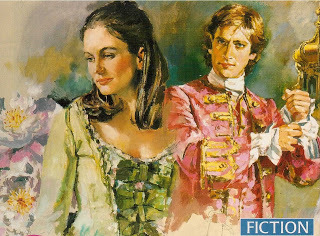 Illustration for BY THE SWORD...New Idea
Illustration for BY THE SWORD...New Idea
Translation to film can be a bit dodgy too...ABC Arts Nation filmed a couple of scenes from THE KING'S MAN - on a very tight budget! If you would like another smile you can see the video on my website. Click Here (although just a warning for copyright reasons it may not work in all countries).
There is a difference between the way men and women think and respond to the written word. I was recently reading an article about the rise of the erotica novel for the female audience (don't look at me...I can't write it!). The writer made the interesting point that women are reading erotica (or romotica) because the interest for them is in their own imaginations. Men on the other hand, prefer the visual stimulation of the image.
How many times have you gone to the movies to see a film translation of a favourite book and come out bitterly disappointed because the characters looked nothing like the characters in the book?
 Speaking from my own "mind's eye" I think the Harry Potter films and the Lord of the Rings trilogy captured the books and, most importantly, how I, the reader visualised the characters. A recent example where the film missed the book completely was Eagle of the Ninth, which I have adored since childhood. Channing Tatum as Marcus? Noooooo!
Speaking from my own "mind's eye" I think the Harry Potter films and the Lord of the Rings trilogy captured the books and, most importantly, how I, the reader visualised the characters. A recent example where the film missed the book completely was Eagle of the Ninth, which I have adored since childhood. Channing Tatum as Marcus? Noooooo!
Alison

Good writing relies on the writers and readers imagination, on that big muscle between the ears. I was recently asked at a book talk who I had used as a model for the hero in THE KING'S MAN. The answer was no-one. When I write, I will give the characters height, build, eye colour, shape of face, hair colour and cut but anything more than that is up to the reader. If you read the descriptions I have written of Kit Lovell, he could fit the profile of "any man". What I deliberately chose to do was leave the visualisation to the reader. If the reader wanted him to look like Hugh Jackman or Alex O'Louglin, they were free to do so and when we went around the room, every person had a different model in their "mind's eye" as they read the book.
As an aside: Eye colour plays an important part in books but in reality I don't think we really notice the colour of people's eyes, unless they are striking in some way. At a recent writers retreat, as an exercise we had to write a description of the person sitting next to us. Despite the fact we were sitting just about on top of each other, I found myself squinting at my neighbour's eyes, having no idea what colour they were even though I have known her for years. How many descriptions do you read of the hero noticing the heroine's blue eyes from across the crowded drawing room or in one recent example I read - from the bottom of the garden?
The phrase "lose yourself in a book" captures the work of a good writer if the reader can drop themselves into a world that is really their own imagination, fuelled only by written cues from the writer.
Even illustrations don't really capture characters as the mind's eye visualises them. Many years ago, a two part excerpt of BY THE SWORD was published in a national magazine. You can imagine my excitement when an artist was commissioned to illustrate the story. I was going to see Jonathan and Kate brought to life! This was the result. Yes, it is worth a giggle or two. Obviously the artist hadn't actually read the book. I ended up with a blonde hero and brunette heroine both dressed in clothes from the wrong period. They looked nothing at all like I had imagined them!
 Illustration for BY THE SWORD...New Idea
Illustration for BY THE SWORD...New IdeaTranslation to film can be a bit dodgy too...ABC Arts Nation filmed a couple of scenes from THE KING'S MAN - on a very tight budget! If you would like another smile you can see the video on my website. Click Here (although just a warning for copyright reasons it may not work in all countries).
There is a difference between the way men and women think and respond to the written word. I was recently reading an article about the rise of the erotica novel for the female audience (don't look at me...I can't write it!). The writer made the interesting point that women are reading erotica (or romotica) because the interest for them is in their own imaginations. Men on the other hand, prefer the visual stimulation of the image.
How many times have you gone to the movies to see a film translation of a favourite book and come out bitterly disappointed because the characters looked nothing like the characters in the book?
 Speaking from my own "mind's eye" I think the Harry Potter films and the Lord of the Rings trilogy captured the books and, most importantly, how I, the reader visualised the characters. A recent example where the film missed the book completely was Eagle of the Ninth, which I have adored since childhood. Channing Tatum as Marcus? Noooooo!
Speaking from my own "mind's eye" I think the Harry Potter films and the Lord of the Rings trilogy captured the books and, most importantly, how I, the reader visualised the characters. A recent example where the film missed the book completely was Eagle of the Ninth, which I have adored since childhood. Channing Tatum as Marcus? Noooooo!Alison
Published on June 11, 2012 16:56
June 4, 2012
She walked to London to visit the Queen...
In 1897, Queen Victoria celebrated her Diamond Jubilee. Sixty Glorious Years. June 22 was declared Jubilee Day and a grand procession through the streets of London was planned. The prime ministers of all the self-governing dominions were invited, and troops from every part of the empire were to be included in the parade.
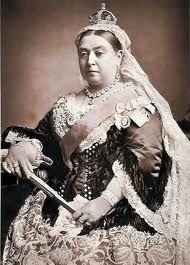 In the small industrial town of of Rawtenstall about 14 miles north of Manchester in Lancashire, a young girl, probably no more than 16 or 17, decided to walk to London to see Queen Victoria's Golden Jubilee procession. I don't know her name, but for the sake of the story, I will call her May.
In the small industrial town of of Rawtenstall about 14 miles north of Manchester in Lancashire, a young girl, probably no more than 16 or 17, decided to walk to London to see Queen Victoria's Golden Jubilee procession. I don't know her name, but for the sake of the story, I will call her May. 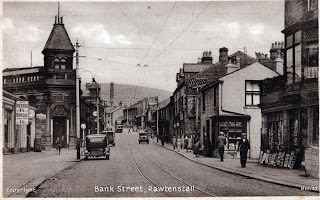 Rawtenstall in the early years of the 20th centuryIt is hard from the distance of over a hundred years to imagine the excitement that pervaded England in 1897, although perhaps we've seen a little of it in the past few days as England celebrates Elizabeth II's Diamond Jubilee. It was the height of the British Empire and presiding over it was the seventy eight year old monarch. Never had any monarch, male or female reigned for so long. Victoria was adored by her subjects which now stretched across every continent. In the little kitchen of May’s two up, two down home in Rawtenstall, built by the industrialists who built the mills that dominated the town, May and and a friend counted their pennies and their hearts must have fallen when they saw they barely had enough for a fare to Manchester, let alone all the way to London. With true Lancastrian grit, these two young girls decided to walk the 177 miles from Rawtenstall to London.
Rawtenstall in the early years of the 20th centuryIt is hard from the distance of over a hundred years to imagine the excitement that pervaded England in 1897, although perhaps we've seen a little of it in the past few days as England celebrates Elizabeth II's Diamond Jubilee. It was the height of the British Empire and presiding over it was the seventy eight year old monarch. Never had any monarch, male or female reigned for so long. Victoria was adored by her subjects which now stretched across every continent. In the little kitchen of May’s two up, two down home in Rawtenstall, built by the industrialists who built the mills that dominated the town, May and and a friend counted their pennies and their hearts must have fallen when they saw they barely had enough for a fare to Manchester, let alone all the way to London. With true Lancastrian grit, these two young girls decided to walk the 177 miles from Rawtenstall to London. I know nothing about how long it took them, where they spent the nights on the road or where they lodged in London. We can assume that the roads of England were filled with loyal subjects all making the same pilgrimage through what was unusually appalling summer weather. Spirits would have been high. This was a moment of high history and they were going to be a part of it.
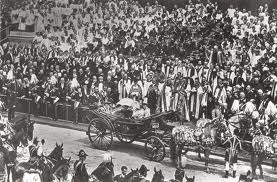 The day of the procession dawned bright and clear. Accompanied by the colonial troops and the great leaders of the Empire, the tiny monarch, dressed in black, and now crippled with arthiritis rode in her open carriage rom Buckingham Palace, via Mansion House, past Parliament and then across Westminster Bridge before recrossing the Thames for a service at St Paul's Cathedral. Lining the route were hundreds of thousands of spectators, huddled beneath bunting and banners - one of which declared Victoria "Queen of earthly Queens".
The day of the procession dawned bright and clear. Accompanied by the colonial troops and the great leaders of the Empire, the tiny monarch, dressed in black, and now crippled with arthiritis rode in her open carriage rom Buckingham Palace, via Mansion House, past Parliament and then across Westminster Bridge before recrossing the Thames for a service at St Paul's Cathedral. Lining the route were hundreds of thousands of spectators, huddled beneath bunting and banners - one of which declared Victoria "Queen of earthly Queens".
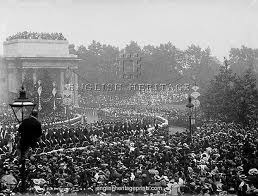 In the poor streets of London (and no doubt all the major cities), the streets were hung with bunting and free feasts for the poor were laid on by wealthy philanthropists. The tea magnate Thomas Lipton laid on one such party with free ale and pipe tobacco. A chain of beacons were lit across Britain and there were fireworks and a son et lumiere was played out on St. Paul’s Cathedral.
In the poor streets of London (and no doubt all the major cities), the streets were hung with bunting and free feasts for the poor were laid on by wealthy philanthropists. The tea magnate Thomas Lipton laid on one such party with free ale and pipe tobacco. A chain of beacons were lit across Britain and there were fireworks and a son et lumiere was played out on St. Paul’s Cathedral. In her journal the Queen wrote: "No one ever, I believe, has met with such an ovation as was given to me, passing through those 6 miles of streets . . . The cheering was quite deafening & every face seemed to be filled with real joy. I was much moved and gratified."
For two young girls from Rawtenstall, it must have been magical. With the last of her money May bought a souvenir of this wondrous occasion, a delicate tea cup decorated with roses and imperial banners, proudly declaring “For Union and for Queen”. She wrapped it carefully and carried it back to Rawtenstall along with the stories of all that she had seen.
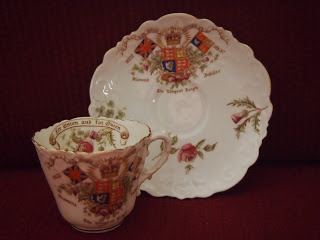
In 1956, as a woman in her late seventies, May became embroiled in a family drama and she was placed in the position of having to formally adopt her grandson, a boy in his early teens. The young social worker assigned to the case, became close to the old woman and when she announced that she would be leaving England to take up a new role in Kenya, the old lady rose to her feet and crossed to her cupboard. From it she took a delicate tea cup and saucer, now cracked but still bearing its clear pattern of roses and imperial flags. “I would like you to have this,” she said to the young woman, “as a momento.”
How do I know this story? The young woman was my mother and the little teacup and saucer, now professionally mended, has pride of place in her home (along with a souvenir of the present Jubilee). Across the span of time, she no longer remembers the name of the woman who gave it to her, but she remembers the story she was told....of the young girl who walked from Rawtenstall to London to see the Queen.
Published on June 04, 2012 23:39
May 28, 2012
Hint of History - To Kill a King

So often truth is stranger than fiction, coincidence happens every day in real life but put it in fiction and it looks contrived and sometimes as a writer you come across real events and people that you couldn't have dreamed up in your wildest imagination.
 Oliver CromwellThis was the case when I was writing THE KING'S MAN. What began as a single paragraph in Antonia Fraser's excellent biography of Cromwell, became the basis for a whole story. In February 1654 Oliver Cromwell, on his way to dine with the Lord Mayor of London, in much state (and wearing a "musk" coloured suit) had his grand parade halted when a brick bat was thrown at his coach by a "Miss Granville". I never discovered who the real Miss Granville was or why she hurled a brick bat at Oliver Cromwell's coach but I had fun writing a story about her.
Oliver CromwellThis was the case when I was writing THE KING'S MAN. What began as a single paragraph in Antonia Fraser's excellent biography of Cromwell, became the basis for a whole story. In February 1654 Oliver Cromwell, on his way to dine with the Lord Mayor of London, in much state (and wearing a "musk" coloured suit) had his grand parade halted when a brick bat was thrown at his coach by a "Miss Granville". I never discovered who the real Miss Granville was or why she hurled a brick bat at Oliver Cromwell's coach but I had fun writing a story about her.As I started to read more about the events of 1654, I uncovered a nest of plots against the life of Oliver Cromwell.
In February, the same month as Miss Granville was hurling brickbats at the Lord Protector, a small group of disaffected royalists were meeting in the Ship Tavern in the Old Bailey, hatching a plot to seize Whitehall, St. James and the Tower and the guards about the city. Captain Dutton was dispatched to garner support from known Royalists in the country and it was decided Colonel Whiteley should go to France to get the support of the King in exile. An argument about payment of his expenses ensued with none of his co-conspirators willing to pay a farthing. One of their number (I won't say who) betrayed the plot to Thurloe and the conspirators were arrested at the Ship Inn. None of those concerned were ever brought to trial.
However during the course of examining the conspirators the existence of a more serious organisation, apparently holding the King's Commission, was revealed. Known as "The Sealed Knot", it had been formed some time in 1653. This was the only group of plotters who were to be any real threat to the Protectorate and when they eventually rose in 1655, were swiftly subdued. Charles II himself appeared to be ambivalent to much of the plotting. He did not believe that the assassination of Cromwell would necessarily result in his return to the throne and in that he was probably correct. At that time Cromwell was at the height of his power and he had able Lieutenants who would have stepped into his place.
In May of 1654 another plot headed by John Gerard was hatched. The plan was to seize Cromwell as he travelled between Whitehall and Hampton Court. Fortunately for Cromwell, his ever efficient Secretary of State, John Thurloe (see my blog on John Thurloe on Hoydens and Firebrands) through his efficient penetration of such enterprises foiled the plot. The conspirators were tried, three were transported and two executed.
Implicated in "Gerard's Plot" (as it came to be known) was an absurd character, a French emissary sent by Cardinal Mazarin to aid the French Ambassador, Bordeaux, in diplomatic negotiations with the English. De Baas was a Gascon whose brother Charles adopted his mother's name D'Artagnan and was the protoype of Dumas' hero (yes really!). De Baas was brash and overconfident and with little understanding of the English decided that Cromwell's regime was of no importance and could easily be overthrown. His arrogance was manifest in his refusal to uncover his head in the presence of the Lord Protector and his assertion that the soldiers who supported the regime were "feeble and dissipated". His grounds for this assertion? The sentinels on duty wore "nightcaps under their hats". On the discovery of the plot the arrogant Frenchman was given three days to leave the country.
With such a bizarre cast of characters, THE KING'S MAN practically wrote itself.
 John ThurloeOne of my favourite characters remains John Thurloe. I own a rather fine print of him that hangs on my staircase. Someone recently asked me if I felt I was being true to John Thurloe in my books. I think the key to the man is in the famous words of Richard Cromwell who once famously remarked “Thurloe has the ability to find the key to unlock wicked mens’ hearts”. While the tactics my fictional Thurloe may employ are entirely figments of my own imagination, I think they are consistent with his modus operandi. He had the ability to exploit a man's weakness which he tries and fails with Jonathan Thornton in BY THE SWORD and succeeds with Kit Lovell in THE KING'S MAN.
John ThurloeOne of my favourite characters remains John Thurloe. I own a rather fine print of him that hangs on my staircase. Someone recently asked me if I felt I was being true to John Thurloe in my books. I think the key to the man is in the famous words of Richard Cromwell who once famously remarked “Thurloe has the ability to find the key to unlock wicked mens’ hearts”. While the tactics my fictional Thurloe may employ are entirely figments of my own imagination, I think they are consistent with his modus operandi. He had the ability to exploit a man's weakness which he tries and fails with Jonathan Thornton in BY THE SWORD and succeeds with Kit Lovell in THE KING'S MAN.TO CLAIM A FREE E-BOOK COPY OF THE KING'S MAN, Click HERE and quote coupon # PW62B at checkout. This offer is only available until June 1.
(And if you like the book, please stop by Kindle or Goodreads and leave a review or rating)
Published on May 28, 2012 16:08
May 21, 2012
Paws for Reflection...Introduction
Until one has loved an animal, a part of one's soul remains unawakened. Anatole France
I cannot imagine a life lived without animals.
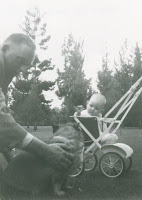 Suzi, the faithful corgi who guarded my pram
Suzi, the faithful corgi who guarded my pramEver since I was a baby there has always been an animal's beating heart in our household. As a child in Kenya, Suzi the corgi dog guarded my pram. After her untimely death (snake bite, my parents said) she was followed by the terminally stupid "guard dog", Corrie, who only barked at white police men (it was colonial days) and had her blanket stolen from underneath her, a miniature dachshund (who thought he was a rottweiler) called Tinker and overseeing them all was the supercilious Siamese cat, Peta, who loathed my mother and adored my father.
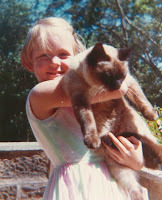 Peta, the supercilious Siamese
Peta, the supercilious SiameseWhen I was ten the family moved to Australia and our first Christmas my well meaning aunt, who had not read the terms of our flat lease, presented my brother and I with a small grey and white kitten, who was given the Swahili name Simba (meaning lion). Simba survived a terrible car accident that had him holed up in the living room of our tiny flat with a broken leg for months. Despite a limp and a stiff left leg "Simmie" lived to a great old age. My parents one attempt to bring a dog back into their lives, the little corgi puppy called Rufus ended in his early death due to a hereditary problem. Heartbroken they never tried with a dog again.
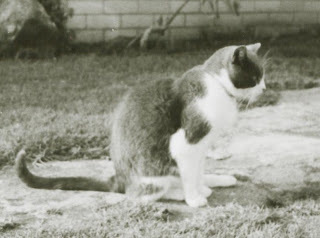 Simba, with his stiff left legMarriage brought a succession of cats beginning with Shasta the black rescue cat who was a wedding present and unfortunately disliked small children and could no longer stay with us after babies came along. Lizzie, the strange little cat who lived in our back yard and had a terror of interiors, Ginger Meggs, the big bad tom who moved in on Lizzie's food bowl and into our hearts, Winston, another rescue, the laid back ginger cat who never learned to cross roads.
Simba, with his stiff left legMarriage brought a succession of cats beginning with Shasta the black rescue cat who was a wedding present and unfortunately disliked small children and could no longer stay with us after babies came along. Lizzie, the strange little cat who lived in our back yard and had a terror of interiors, Ginger Meggs, the big bad tom who moved in on Lizzie's food bowl and into our hearts, Winston, another rescue, the laid back ginger cat who never learned to cross roads.Sarah, the neurotic tortoiseshell, and Wingco, the found Russian Blue, were the resident felines when we moved to Singapore. They relocated to my parents, who were at that time mourning the violent death of their dear little cat in a dog attack. They never moved back.
 Max, the cat with attitude, none of it good
Max, the cat with attitude, none of it goodIn Singapore we rescued Max, the tailless black and white drain kitten with attitude (none of it good). At vast expense Max moved back to Melbourne with us but his attitude did not improve. The arrival of the Kat brothers, Oliver and Toby, was too much for Max who packed his bags and left home.
The Kat brothers now rule our lives.
 The Kat brothers - Toby and Oliver as kittensThe dear man I have been married to for 28 years does not like dogs...not at all. If you were to meet him you would think "Now there's a dog man", but (my darling husband...DH) DH is a cat man through and through. I have threatened to replace him with a dog on many occasions but despite a family propensity for cat allergies, he adores his cats.
The Kat brothers - Toby and Oliver as kittensThe dear man I have been married to for 28 years does not like dogs...not at all. If you were to meet him you would think "Now there's a dog man", but (my darling husband...DH) DH is a cat man through and through. I have threatened to replace him with a dog on many occasions but despite a family propensity for cat allergies, he adores his cats.Of course I had two sons and in among the cats, there were fish and mice. Give an animal a name and it binds the animal to you. I have wept buckets over mice!
Family tradition continues and my youngest son and his partner now have a dear little rescue cat who is affectionately referred to (at least by me) as the "grandkitten".
Each animal brought their own personality and their own brand of affection into our lives (even Max...the cat with attitude...had his moments) and over the next few months I would like to share some of their stories with you and I also hope to bring stories from guest bloggers about the animals in their lives in a regular monthly column called "Paws for Reflection"...Please feel free to share your thoughts about significant animals in your lives.
Published on May 21, 2012 18:45
April 26, 2012
Recipe for Writing
One thing I have learned in my year's of honing the craft of a writer is that no two writers write the same way. By that I mean we all have a different method to achieve the outcome. The subject of Plotters vs Pantsers is often discussed on blogs.
I prefer to use the term "organic" writer. I have tried sitting down and plotting a novel in the sure and certain knowledge that it will save me a great deal of time and anguish but as I stared at the pile of cards/large sheet of newsprint or whatever method plotters employ, I realised I was now completely bored with the story and it would never be written. For me the joy in writing is watching the plot and characters unfold like peeling back the layers of an onion.
I will begin with a scenario, a basic cast of characters and a few stopping off points along the way. The great thing about writing romance is you do already know the ending. The hero and heroine will end with the promise of a HEA (Happy Ever After). It's how they get there and what difficulties will they overcome that is the fun part.
I have titled this blog the Recipe for Writing because I view my 'methodology' as pots on a stove top.
My first draft is my equivalent of "plotting". I begin at the beginning and go on until I come to the end, generally without much editing. I throw in the basic ingredients and the result is something vaguely book shaped. It has a beginning a middle (although that may be prone to sagging) and an end. I then need to put it away for a month or two...or in my analogy...put it on the back burner to simmer.
If I am being good, then there will be at least 4 pots on this stove of imagination (see picture below)...all books at various stages of production. By putting my rough draft to the back it means that another story moves forward for its final revision, polish and submission. Dish it up to a publisher and off it goes...
Circle the pots again. The next pot has been revised once but needs a deal more spit and polish. Add some more spice, stir it up and back it goes to the back burner.
Now my rough draft is back again. I look at it with cold, hard eyes and begin the job of adding in those extra ingredients, beating it to a smooth paste, bringing it to the boil and then turning down the heat. It is beginning to look like a book.
And so on through the creative process.
 That's just the way I work. If I talk to other writers they couldn't bear the thought of not sticking with the one story from beginning to end and back again until it is absolutely perfect and are faintly aghast at my method. However I think that's the wonderful thing about writers - we are all different.
That's just the way I work. If I talk to other writers they couldn't bear the thought of not sticking with the one story from beginning to end and back again until it is absolutely perfect and are faintly aghast at my method. However I think that's the wonderful thing about writers - we are all different.
I prefer to use the term "organic" writer. I have tried sitting down and plotting a novel in the sure and certain knowledge that it will save me a great deal of time and anguish but as I stared at the pile of cards/large sheet of newsprint or whatever method plotters employ, I realised I was now completely bored with the story and it would never be written. For me the joy in writing is watching the plot and characters unfold like peeling back the layers of an onion.
I will begin with a scenario, a basic cast of characters and a few stopping off points along the way. The great thing about writing romance is you do already know the ending. The hero and heroine will end with the promise of a HEA (Happy Ever After). It's how they get there and what difficulties will they overcome that is the fun part.
I have titled this blog the Recipe for Writing because I view my 'methodology' as pots on a stove top.
My first draft is my equivalent of "plotting". I begin at the beginning and go on until I come to the end, generally without much editing. I throw in the basic ingredients and the result is something vaguely book shaped. It has a beginning a middle (although that may be prone to sagging) and an end. I then need to put it away for a month or two...or in my analogy...put it on the back burner to simmer.
If I am being good, then there will be at least 4 pots on this stove of imagination (see picture below)...all books at various stages of production. By putting my rough draft to the back it means that another story moves forward for its final revision, polish and submission. Dish it up to a publisher and off it goes...
Circle the pots again. The next pot has been revised once but needs a deal more spit and polish. Add some more spice, stir it up and back it goes to the back burner.
Now my rough draft is back again. I look at it with cold, hard eyes and begin the job of adding in those extra ingredients, beating it to a smooth paste, bringing it to the boil and then turning down the heat. It is beginning to look like a book.
And so on through the creative process.
 That's just the way I work. If I talk to other writers they couldn't bear the thought of not sticking with the one story from beginning to end and back again until it is absolutely perfect and are faintly aghast at my method. However I think that's the wonderful thing about writers - we are all different.
That's just the way I work. If I talk to other writers they couldn't bear the thought of not sticking with the one story from beginning to end and back again until it is absolutely perfect and are faintly aghast at my method. However I think that's the wonderful thing about writers - we are all different.
Published on April 26, 2012 23:03
April 12, 2012
GATHER THE BONES - Update
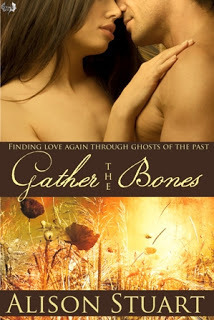
Coming in August 2012 - a new novel by Alison StuartGATHER THE BONESpublished by Lyrical Press
Set in 1923 against a background of the Great War, grieving war widow, Helen Morrow and her husband’s cousin, the wounded and reclusive Paul are haunted not only by the horrors of the Great War but ghosts from another time and another conflict. A coded diary provides the clues to the mysterious disappearance of Paul’s great grandmother in 1812. As the desperate voice of the young woman reaches out to them from the pages, Paul and Helen are bound together in their search for answers, not only to the old mystery but also the circumstances surrounding the death of Helen’s husband at Passchandaele in 1917. As the two stories become entwined, Paul and Helen will not find peace until the mysteries are solved.
Published on April 12, 2012 17:02
April 9, 2012
Lucky No 7 Meme
Thanks, Anita Davison, for joining me to the Lucky No. 7 Meme. I"m still not entirely sure what a "meme" is but, hey, I am one of the world's great "joiners" so here we go.
Instructions: *go to page 77 of your current WIP*go to line 7*copy down the next 7 lines/sentences as written and post them on your blog or website*tag 7 other authors*let them know they've been tagged
The following is an extract from my soon to be published novel GATHER THE BONES... (August 2012)In the late afternoon, Paul abandoned thelibrary and adjourned to his own rooms. He sat at a table by the window, apencil in his mouth and his right hand curled around a glass of whiskey,looking at a sheet of paper on which he had scribbled some notes for histranslation of "The Iliad.""I knocked but you didn't answer"Paul started, nearly knocking over thewhiskey. Helen stood with her hand on the door handle."Come in," he said. "Sorry, I was a bitpreoccupied. When did you get back?""About half an hour ago. I brought thecigarettes you asked Sam to get," she said."Thanks, leave them on that table." Hewaved a hand in the direction of the small table. Helen set the packet down andcrossed over to the window to join him.
OK...that probably wasn't the most rivetting excerpt. It gets more exciting I promise!
Tagging love to be shared with (in no particular order):Erin GraceAnnie SeatonBronwyn StuartTracey O'haraJennie BrumleyTamara GillAnne Brear
Enjoy the Extracts!Alison
Published on April 09, 2012 19:19
April 1, 2012
Richard Lovelace and the Cavalier Poets
Over at Hoydens and Firebrands this week I am writing about the most romantic of the cavalier poets, Richard Lovelace.
To Lucasta, Going To The Wars
Tell me not (Sweet) I am unkind,That from the nunneryOf thy chaste breast and quiet mindTo war and arms I fly.
True, a new mistress now I chase,The first foe in the field;And with a stronger faith embraceA sword, a horse, a shield.
Yet this inconstancy is suchAs you too shall adore;I could not love thee (Dear) so much,Lov'd I not Honour more.
And this beautiful version of To Althea from Prison by Fairport Convention.

To Lucasta, Going To The Wars
Tell me not (Sweet) I am unkind,That from the nunneryOf thy chaste breast and quiet mindTo war and arms I fly.
True, a new mistress now I chase,The first foe in the field;And with a stronger faith embraceA sword, a horse, a shield.
Yet this inconstancy is suchAs you too shall adore;I could not love thee (Dear) so much,Lov'd I not Honour more.
And this beautiful version of To Althea from Prison by Fairport Convention.
Published on April 01, 2012 16:10
March 4, 2012
READ AN E-BOOK WEEK Mar 4-10
It's Read an E-book week and over at Smashwords you can get BY THE SWORD and THE KING'S MAN for 50% discount. TOWER OF TALES is FREE (that's right FREE!).
All books are available in multi-formats so if you haven't tried my books before, now is the chance. Reviews are welcome!
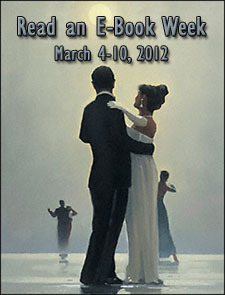

All books are available in multi-formats so if you haven't tried my books before, now is the chance. Reviews are welcome!

Published on March 04, 2012 19:34
January 29, 2012
Rediscovering Reading
This may sound a strange blog title...particularly coming from a writer but the sad truth is that in this busy world, I have lost the art of reading. Reading has been reduced to a self indulgent pleasure or a few snatched chapters before switching off the light at night.
To my shame, I get hopping mad when my husband starts to read because he is utterly single minded. He will sit and read a book from cover to cover in one sitting given half a chance and while I'm flitting around the house being busy and doing "stuff", he is sitting there READING A BOOK. He will then take it to bed and read it into the wee small hours without a thought that the light is driving his companion crazy!
I have just returned from a week in beautiful New Caledonia, most of which I spent by myself in a hotel in Noumea. DH (who was doing a site visit in the north of the island) joined me for the weekend. The 4 days I spent by myself, I DID very little. Normally I have to train for holidays which are spent madly rushing around trying to see and do as much as we can in a short space of time.
 WRITER AT WORK
WRITER AT WORK
Instead I wrote, I thought, I plotted and I read.
In keeping with my commitment to the Australian Women Writers Challenge I read Australian Women authors and here is the list.
THE FORGOTTEN GARDEN: Kate Morton
A small child is found alone on a dock in Australia 1913 with nothing but a small white suitcase containing a book of fairy tales. This story traces the story of that little girl and the search for her identity. It is told through the eyes of the child as an older woman, her granddaughter and the mysterious "authoress" of the fairy tale book. What unfolds is a complex story of social class and rejection in the late nineteenth century. It is not a pretty tale and the fairy stories themselves give more clues to the true story and hints at a darker story than the one revealed on the surface. As the story moves between not only the three women's point of view, but also a fair smattering of the secondary characters, it is not an easy book to "get into". However once the rhythm is established it is a compelling with a satisfactory ending, at least for the granddaughter, Cassandra, who has her own demons to bear.
INTRODUCING THE HONOURABLE PHRYNE FISHER: The first 3 Phryne Fisher novels: Kerry Greenwood
The wonderful Phyrne Fisher is the subject of seventeen books and is shortly to appear on our screens (ABC) in a series of single episodes based on a number of her books. Phryne is a "modern woman" of the 1920s, totally confident in her abilities and sexuality. Of course it helps to gorgeous and independently wealthy! The first 3 Phyrne books establish Phryne in Melbourne society and her cast of characters that surround her. Kerry's portrait of 1920s Melbourne is not tinged with rose. It was a rough and ugly world if you were poor and even though the root of the book is firmly local, the stories are universal (and just the right length for an easy holiday read).
BOOMERANG BRIDE: Fiona Lowe
Fiona Lowe writes as HMB "medical author" and Boomerang Bride is her first venture outside that sub genre into the wider world of romantic fiction with a "feisty" Australian bride turning up in small town Wisconsin looking for her online fiancee. Instead she meets Eric the viking. This is a wonderful story, written with a deft and light touch. Fiona's deep affection for a part of the USA she know well comes through and the cast of secondary characters are beautifully drawn with the right amount of pathos/humour. Despite knowing this is a romance and it will end HEA, there are enough credible twists and turns along the way to keep the protagonists at a distance while they come to know not only each other but their inner selves.
BRIDE BY MISTAKE: Anne Gracie
I did what my husband normally does...I read this book from cover to cover in one day. Admittedly most of that was spent on a long boat ride to an island, followed by an extended sit on a tropical beach. This is the last of Anne's Devil Rider series and I've loved them all. What I particularly like about Anne's writing is that she doesn't shy away from the reality of the period. Most of Regency England was spent at war and the men who returned from the war were inevitably damaged - physically and emotionally. Anne doesn't hold back in depicting the horror of what they endured and Luke, more than any of the other Devil Riders, is a badly wounded hero (all right I am a complete sucker for wounded heroes!) but so is Bella and together they have to heal the wounds of their horrible war.
I also started: HOUSE OF WOMEN: Ann Whitfield also writing as Anne Brear
All Aussie women writers and all different! The only actual book I took with me was the Anne Gracie, the rest were transported via Kindle (imagine lugging that many books in your suitcase!). I am a total convert to ebooks!
In his few days with me, DH polished off his latest book (Dan Brown...say no more!) and "in desparation" picked up and read the Anne Gracie - in twenty four hours. A great fan of Bernard Cornwell and the wonderful Sharpe series, he chuckled his way through Luke and Bella's adventures and when he finished (with a smile on his face) pronounced it a "lovely story". Consider that a review!
What have you been doing for your holidays (summer or winter!) and what reading has taken your fancy?

To my shame, I get hopping mad when my husband starts to read because he is utterly single minded. He will sit and read a book from cover to cover in one sitting given half a chance and while I'm flitting around the house being busy and doing "stuff", he is sitting there READING A BOOK. He will then take it to bed and read it into the wee small hours without a thought that the light is driving his companion crazy!
I have just returned from a week in beautiful New Caledonia, most of which I spent by myself in a hotel in Noumea. DH (who was doing a site visit in the north of the island) joined me for the weekend. The 4 days I spent by myself, I DID very little. Normally I have to train for holidays which are spent madly rushing around trying to see and do as much as we can in a short space of time.
 WRITER AT WORK
WRITER AT WORKInstead I wrote, I thought, I plotted and I read.
In keeping with my commitment to the Australian Women Writers Challenge I read Australian Women authors and here is the list.
THE FORGOTTEN GARDEN: Kate Morton
A small child is found alone on a dock in Australia 1913 with nothing but a small white suitcase containing a book of fairy tales. This story traces the story of that little girl and the search for her identity. It is told through the eyes of the child as an older woman, her granddaughter and the mysterious "authoress" of the fairy tale book. What unfolds is a complex story of social class and rejection in the late nineteenth century. It is not a pretty tale and the fairy stories themselves give more clues to the true story and hints at a darker story than the one revealed on the surface. As the story moves between not only the three women's point of view, but also a fair smattering of the secondary characters, it is not an easy book to "get into". However once the rhythm is established it is a compelling with a satisfactory ending, at least for the granddaughter, Cassandra, who has her own demons to bear.
INTRODUCING THE HONOURABLE PHRYNE FISHER: The first 3 Phryne Fisher novels: Kerry Greenwood
The wonderful Phyrne Fisher is the subject of seventeen books and is shortly to appear on our screens (ABC) in a series of single episodes based on a number of her books. Phryne is a "modern woman" of the 1920s, totally confident in her abilities and sexuality. Of course it helps to gorgeous and independently wealthy! The first 3 Phyrne books establish Phryne in Melbourne society and her cast of characters that surround her. Kerry's portrait of 1920s Melbourne is not tinged with rose. It was a rough and ugly world if you were poor and even though the root of the book is firmly local, the stories are universal (and just the right length for an easy holiday read).
BOOMERANG BRIDE: Fiona Lowe
Fiona Lowe writes as HMB "medical author" and Boomerang Bride is her first venture outside that sub genre into the wider world of romantic fiction with a "feisty" Australian bride turning up in small town Wisconsin looking for her online fiancee. Instead she meets Eric the viking. This is a wonderful story, written with a deft and light touch. Fiona's deep affection for a part of the USA she know well comes through and the cast of secondary characters are beautifully drawn with the right amount of pathos/humour. Despite knowing this is a romance and it will end HEA, there are enough credible twists and turns along the way to keep the protagonists at a distance while they come to know not only each other but their inner selves.
BRIDE BY MISTAKE: Anne Gracie
I did what my husband normally does...I read this book from cover to cover in one day. Admittedly most of that was spent on a long boat ride to an island, followed by an extended sit on a tropical beach. This is the last of Anne's Devil Rider series and I've loved them all. What I particularly like about Anne's writing is that she doesn't shy away from the reality of the period. Most of Regency England was spent at war and the men who returned from the war were inevitably damaged - physically and emotionally. Anne doesn't hold back in depicting the horror of what they endured and Luke, more than any of the other Devil Riders, is a badly wounded hero (all right I am a complete sucker for wounded heroes!) but so is Bella and together they have to heal the wounds of their horrible war.
I also started: HOUSE OF WOMEN: Ann Whitfield also writing as Anne Brear
All Aussie women writers and all different! The only actual book I took with me was the Anne Gracie, the rest were transported via Kindle (imagine lugging that many books in your suitcase!). I am a total convert to ebooks!
In his few days with me, DH polished off his latest book (Dan Brown...say no more!) and "in desparation" picked up and read the Anne Gracie - in twenty four hours. A great fan of Bernard Cornwell and the wonderful Sharpe series, he chuckled his way through Luke and Bella's adventures and when he finished (with a smile on his face) pronounced it a "lovely story". Consider that a review!
What have you been doing for your holidays (summer or winter!) and what reading has taken your fancy?
Published on January 29, 2012 17:12



